The “Tram” Line
The Tram Line scene is actually a sub-scene contained entirely within the Urban Station scene, and largely hidden from view behind the station and the adjacent buildings.
A “tram” is a colloquial name for an urban light rail vehicle (LRV), more commonly known in the U.S. as a trolley. English references to Japanese LRVs almost exclusively call them “trams”, and so will I.
The tram line extends the idea of the elevated station as a transportation hub. From there, locals can catch inter-city Shinkansen, local commuter and subway trains, buses, taxis or the neighborhood tram. While no single station in Tōkyō has all of these (there are no Shinkansen stations there that connect to trams), these kinds of interconnections are a major part of what makes the city’s public transportation network so usable, and heavily used.
This was a late addition to the design (replacing an earlier freight railroad dropped due to lack of space), and as such there aren’t many photos yet. Rolling stock will be one or two Tōkyū railway 300 series articulated trams. In addition to a platform under the elevated station, it is expected to have two other stops, one mid-route and another at the far end, both at the rear of the Urban Station scene.
The idea is that the running tram will be partially hidden from view by the buildings lining the commercial avenue paralleling the elevated station, and will pop in and out of sight, adding some interesting activity, without requiring much additional detailing of the line. It will also occupy space I’d otherwise have to fill with buildings. Trains will run on DC power using a simple controller. I'd originally planned to use an RU2-1, which is a popular controller for such applications, allowing up to five stations. However, as this only works with a single tram, I instead decided to build my own controller using an Arduino. That's a bit of a project, so I won't get to it soon. In the short term, I’ll use one of my Kato power-packs and run manually.

Here is a track plan showing just the tram line and its stations. It will have single-track stations at each end: one (C) under the viaduct station, adjacent to the subway platforms plus another (A) at the far end, and a double-track station (B) somewhere in the middle. The idea is that it will run along the backdrop behind a row of buildings. This has been roughed-in, but my plans may change before all is said and done.
I’m also trying something else new here: I’m going to use Tomix Mini-Rail (a subtype of their Finetrack product line, similar to Kato’s Unitrack). The reason is that it has very small-radius curves (I’m using 140mm and 177mm; they also make a 103mm “super mini-rail” curve, but articulated trams are reputed to have problems with it). Although Tomix makes adapters for creating street-track using Mini-Rail and now a version of Mini-Rail embedded in a street structure, I’m going to replicate the private right-of-way of the prototype, so I won’t be using that, except perhaps on the curve where it crosses the street.
And the prototype I'm drawing most heavily from is the Tōkyū Railway's Setagaya Line, a 1372mm (4' 6") gauge line in western Tōkyō that's home to the 300 series trams I'm using, but I'm also influenced by Tōkyō other tram line, the Toden Arakawa Line, another 1372mm (4' 6") gauge line on the north side of the city.
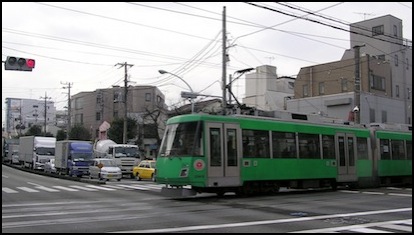
Setagaya 300 Series crossing Kannana Dōri (rt. 318)
Photographer: Nemo’s great uncle (2007)
The Tōkyū Setagaya Line seen here runs mainly in off-street private right-of-way. The Toden Arakawa line has a small section of street-running, and in a few places runs in median strips separated except at grade crossings, but also largely uses a separate right-of-way.
My first tram is a Tōkyū Setagaya Line 300-series tram, which is a two-car articulated unit. The model is made by Modemo, which makes models of many Japanese trams.
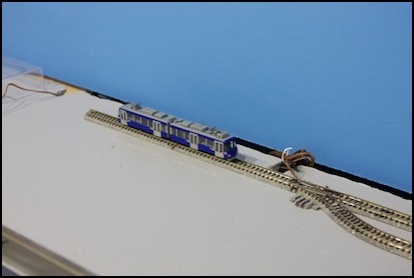
The tram, parked at one terminal of the tram line. The track is Tomix finetrack, with “Mini-Rail” curves (140mm and 177mm) and switches (a 140mm curve). The switch acts as a spring switch, so I can leave it set to direct outbound trams to the left track, and it will pass inbound trams from the right track (and it does), so I don’t expect to hook up the electric control to throw the switch at all.
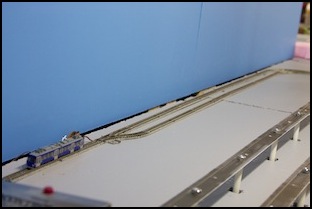
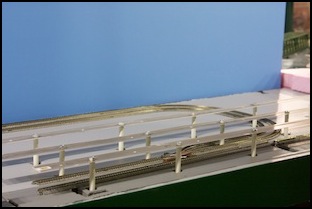
Tram Line alignment, without buildings. Behind the buildings (left) and under the station (right)
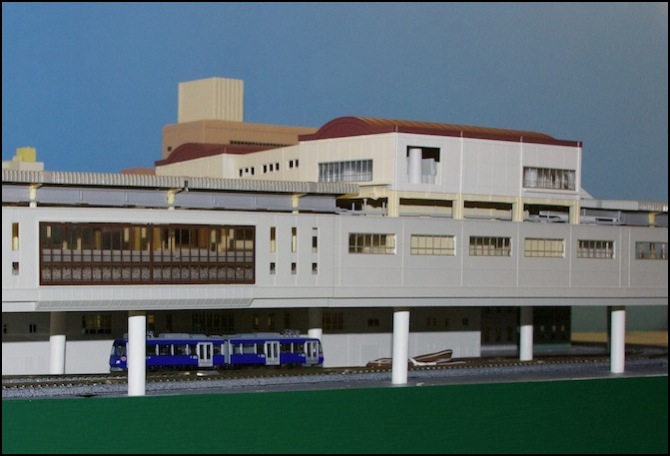
The Overhead Transit Station, with tram and entrance building (behind tram).
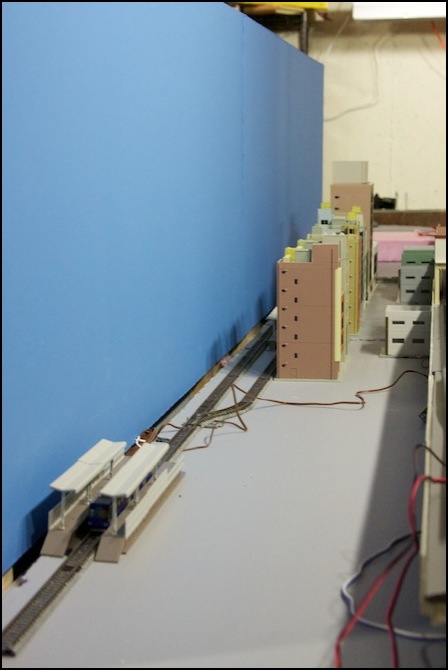
Tram line with two side platforms at the terminal end. You can just see the island platform between the tracks to the left of the brown building. The third station is under the viaduct on the right (see station photo above).




